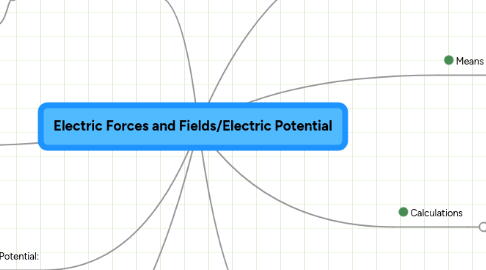Electric Forces and Fields/Electric Potential
por Rizzalyn Bagacina


1. Electric Potential Energy
1.1. Energy stored in an electric field
1.2. Ue=k(q1*q2)/r
1.3. Signs of Charges determine sign of PE
2. Electric Potential
2.1. Electric potential energy per unit charge
2.2. V=U/q
2.3. 1V=1 J/C
2.4. Potential Difference: change in electric potential energy/unit charge
3. Electric Field and Potential:
3.1. Equipotential Surface
3.1.1. Same potential at every point on the surface
3.1.2. perpendicular to electric field lines at all points
4. Coulomb's Law
4.1. F= k(q1xq2)/r2
4.1.1. k=8.99e9
4.2. F=electrical force each charge exerts on the other
5. Properties of Charge
5.1. *Law of Conservation of Charge*: net charge of a closed system never changes.
5.2. Like Charges repel one another, unlike charges attract one another
6. Means of Charging/Discharging
6.1. Conduction: some charge can move easily
6.2. Charging a conductor: Rubbing
6.3. Semiconductor: intermediate between insulator/conductor
6.3.1. Photoconductor: uses light--no light=insulator, light=conductor
6.4. Insulator: charge does not move easily
6.4.1. Glass, plastic, rubber, wood
6.5. Grounding: process of discharging a conductor
7. Calculations
7.1. Electrical Field(E)=Electric force(F)/q
7.2. F=(k*q*Q)/r2
7.2.1. Q=single point charge
